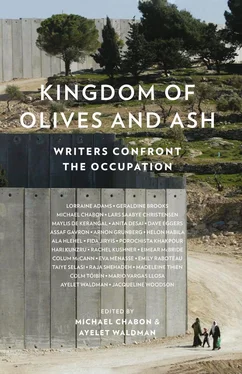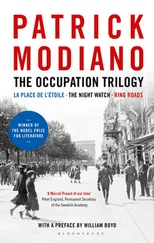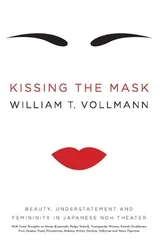Pisgat Ze’ev, named for the Revisionist Zionist Ze’ev Jabotinsky, was one of the new settlements rapidly built on land annexed by Israel after the war, intended to connect and thicken the Jewish areas of East Jerusalem. Although the annexation remains illegal under international law (the United States, for one, does not recognize it), Pisgat Ze’ev is now one of Jerusalem’s largest neighborhoods, with some forty-two thousand residents, around five hundred of them Palestinians. Shady trees have grown up, softening the lines of its medium-rise, stone-clad apartment blocks and humming commercial areas.
Beit Hanina has grown organically over time from its village origins, and it contains a range of old and new homes. Some thirty-five thousand Palestinians live there, on land Israel has annexed. Another thousand have been severed from their neighbors by the building of the separation barrier a decade ago, after the wave of suicide bombings that characterized the uprising known as the second intifada. The looming concrete wall, which mostly divides annexed land claimed by Israel from occupied land administered by the Israeli military, has huge implications. Those on the Palestinian side may not cross into annexed East Jerusalem—to go to work or school, to visit family, to buy groceries—without a temporary pass issued at the discretion of the Israeli authorities.
On the other side of the barrier, Palestinians have free movement but often face hostility from Jewish hard-liners, whose numbers have grown with Israel’s tilt to the right in recent years. Residents of Beit Hanina sometimes awake to graffiti messages such as “Death to Arabs” and “Jerusalem for Jews” spray-painted on their homes. Cars have been vandalized and burned, tires slashed. Palestinians put the blame on militants from Pisgat Ze’ev. Pisgat Ze’ev residents can be just as quick to blame Palestinians for crimes in their neighborhood.
Not long ago, a Jewish woman accosted the Manasra boys as they practiced parkour under the highway. She accused them of stealing her son’s gloves. The boys’ uncle, also named Ahmed, who was home at the time, was called to the scene. “When I got down there, the boys were looking like scared rabbits, surrounded by settlers and police,” he says. Because of the wave of vandalism, he and his brothers had installed a security camera on the outside of their compound. He suggested the police review the film to see if the boys had left the play area to go and steal in the Israeli neighborhood. The footage proved they’d been playing innocently under the bridge at the time of the alleged theft. The police, he said, accepted the evidence, but the woman continued to accuse and berate the boys. Ahmed Manasra has thought about that incident, and whether the fear it engendered may have been a kind of tipping point for his nephews. “Our children don’t have normal childhoods,” he says. “From the minute they open their eyes they wake into a reality of checkpoints, soldiers, settlers insulting their mom. They see the news from Gaza, children like them, bombed and homeless. They hear about a boy their age, burned alive by Israelis. They are sad and afraid. It’s not a healthy environment.” Even so, he says, he still can’t bring himself to believe that his nephews were capable of doing what they did on an ordinary afternoon in 2015.
It was a Monday, and Hassan came home as usual from his tenth-grade class at Ibn Khaldoun School, where he excelled at his studies and was known for good behavior. Ahmed, who struggled academically and was considered rather young for his age, returned from the nearby New Generation Primary School. Hassan told his mother he was going out to buy a video game for his PlayStation. He asked what she was making for dinner. He was hungry, he told her, and he wouldn’t be gone long. It was about three o’clock in the afternoon.
In CCTV footage captured soon after, Ahmed and Hassan are seen strolling together towards the shopping district of Pisgat Ze’ev, an easy walk from their home once you get across the busy highway. They appear relaxed and unremarkable—two kids out for a walk after school. They amble out of the shot. Then, suddenly, the camera captures a very different image. A young man, wearing the white shirt and black trousers of the Orthodox, runs past the camera, desperately glancing behind him as the two boys, long knives now unsheathed, chase after him. Although Hassan had already stabbed the man, Yosef Ben Shalom, age twenty-one, in the upper body, he managed to outrun them. The boys turned then, and ran on towards the shops on Sisha Asar Street.
Just minutes later, a few blocks away in her top-floor apartment, Ruti Ben Ezra heard three quick pops. A sinewy woman with jet-black hair and cobalt-blue eyes, she came to Israel in 1977 from Argentina when she was eight years old. Ten years later, she served in the army in Gaza during the first intifada, so she had no doubt that what she heard were gunshots. As she rushed down the stairs to see what had happened, she did a mental accounting of the whereabouts of her five children. Two were still at school, two had gone to play football, and one, Ofek, had just left to visit his grandmother. It was Ofek who came barreling back towards the apartment, screaming. “Mum! Mum! Orlev, Na’or … Terrorist!”
“Go upstairs! Close the door!” she told him, and ran out into the road towards the shopping area. A terrified Orlev ran to her. She grasped his hand as he pulled her to the candy store where his older brother Na’or, thirteen, lay sprawled on the sidewalk. Ruti threw herself down beside her son and called his name, begging him to open his eyes. Within minutes, paramedics were at her shoulder, yelling at her to move.
“No!” she said. “I’m his mother!”
“Do you want us to save him? Then get out of the way.”
She stood back as they worked on her unconscious son. Pulse: weak. Blood pressure: plunging. What was evident to the paramedics was that Na’or had been knifed three times, from behind his shoulder. But the amount of blood on the sidewalk didn’t account for his plummeting vital signs. What was not evident: the deadliest of the wounds had punctured his jugular. Internally, invisibly, he was bleeding to death.
A few blocks away, Hassan Manasra was already dead, shot at close range by police officers as he’d rushed at them with his knife. Farther down the tram tracks, his cousin Ahmed lay where a car had struck him. The impact had sent him sprawling, his lower legs twisted up on either side of his body in a grotesque and unnatural shape, like an action figure cast aside by a careless child. Blood pooled around his skull, fractured by the blow from a club wielded by a storekeeper who’d chased him down.
Despite his head injury, he had not lost consciousness. A cell phone video showed his face, contorted, as a mob gathered around him. A voice yelled: “Die, you son of a whore!”
Within hours, that cell phone footage went viral and Ahmed Manasra became a Rorschach blot; a scrim onto which each side of the conflict could project its own narrative.
The Palestinian leader Mahmoud Abbas was the first to use the boy, erroneously claiming in a televised address that Israelis had summarily executed him. In answer, the Israeli prime minister Bibi Netanyahu released footage of Ahmed in Hadassah Medical Center, head bandaged, being fed pureed food. Palestinians were quick to point out that it was not Israelis offering this succor, but the boy’s Palestinian lawyer, who had noticed the untouched food and realized that Ahmed might not manage to eat it, since his hand was shackled to the bed. On the video, Ahmed is seen raising his free hand, perhaps to shoo the videographer away. An Israeli commentator described the gesture as “an ISIS salute.” Meanwhile, Physicians for Human Rights released a statement decrying the release of the footage as an illegal exposure of the identity of a minor and an unethical violation of patient privacy.
Читать дальше











